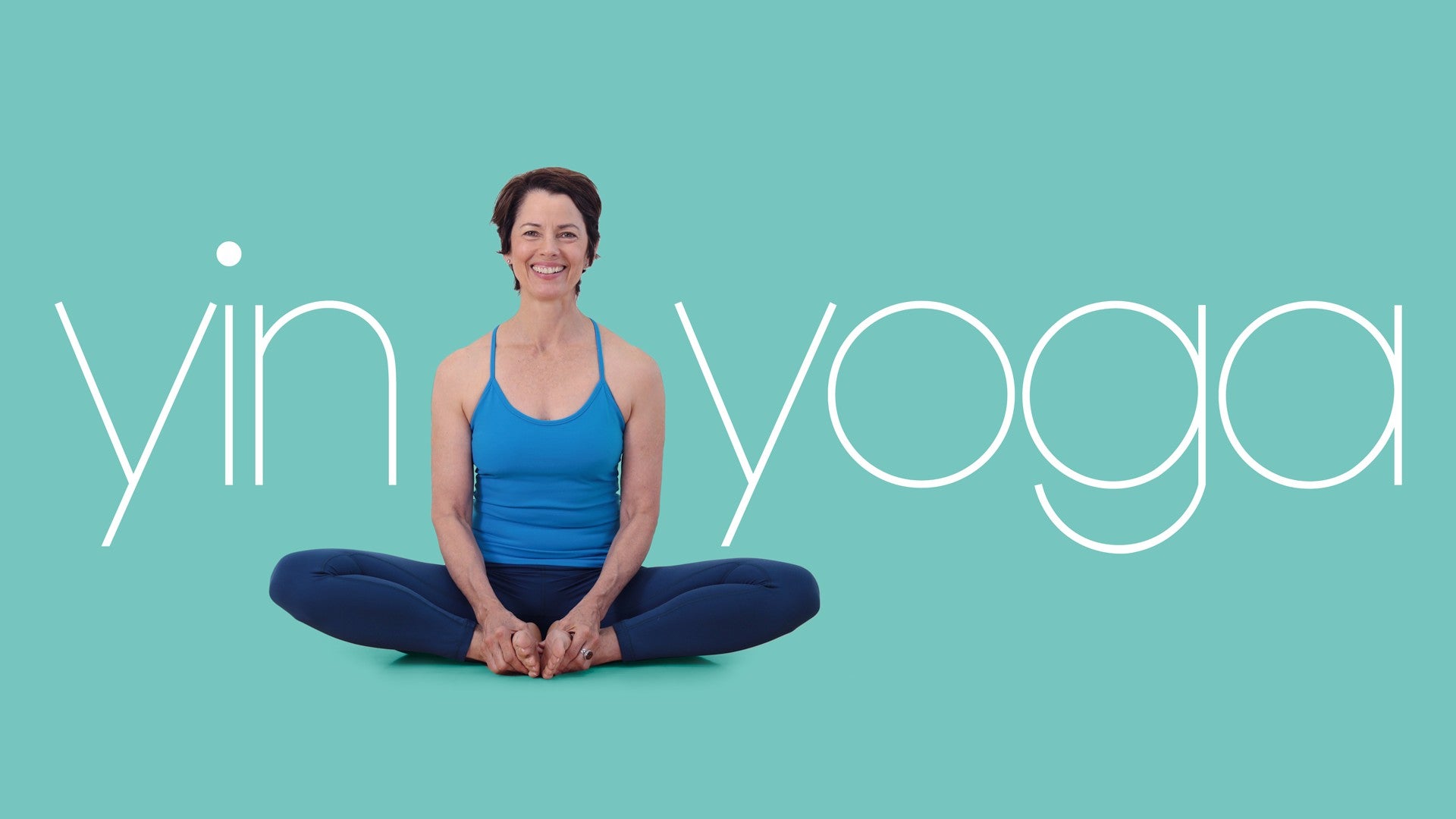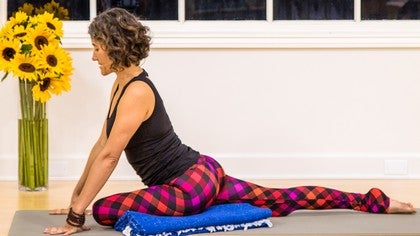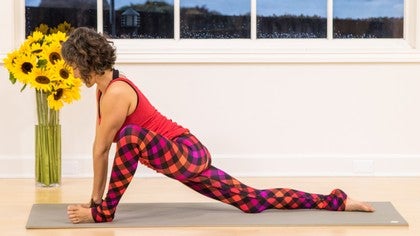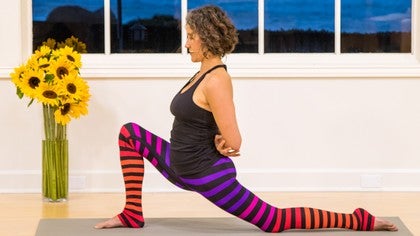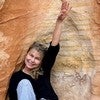Description
About This Video
Transcript
Read Full Transcript
(waves lapping) Nice to see you again. So we'll start to add a few more shapes and yet we'll continue to keep our holding time around that two to three minutes, so that we're still just getting used to offering ourself towards ourselves for extended periods of time. I'm going to be using a blanket in this sequence. It's not necessary, but sometimes in these long-held postures it's nice to have a little bit of padding so the mantra just doesn't become (mumbling). We'll start in child's pose.
Find yourself at the back of the mat. Knees might be together, kind of depends on how you're designed. They might be slightly apart. And then just kind of wiggle on down. Find your chest towards your thighs perhaps.
Forehead may touch the earth. If your forehead doesn't touch the earth though, perhaps use your hands underneath your forehead or your blanket. Okay, we'll be here just about half a minute. Big, deliberate inhale. Exhale, let (sighs) happen.
Let the hips get heavy. And do that again, inhale. And exhale, let (sighs) happen. Child's pose is not such an easy pose if your joints aren't used to bending. Okay, nice.
From here let yourself come up onto all fours. Now again, I suggest putting a little padding down for underneath your knee. You may or may not agree with that suggestion. Bring your left foot forward between your hands. Leave your right knee back on the padding.
And then begin to introduce yourself. So we'll be here for about two minutes. Inhale, draw back a little bit. Exhale, sink in. And do that again.
Inhale, draw back a little bit. And exhale, sink in. And do that at least one or two more times. So by drawing back and sinking in you're letting the front of that thigh know what's happening. Now as you sink into this lunge, while the primary spot we're hoping to touch is the front of that right thigh, you might be more aware of the back of your left hamstring.
It just depends on how you're put together. And if this is feeling like too much you might have your hands up on two bricks. Okay, the play here now is to allow your hip to get heavy. Soften the jaw and kind in the eyes. I usually like to roll it around a little bit.
I like to kind of check out what's going on over there on the right. What's going on in that inner thigh. Let the right sit-bone and buttocks relax. Let the throat be easy. Anatomically, you might have both hands on either side of the foot, but some of you might be more inclined to have the hands, you know, towards each other.
So left hand on the inside of that left foot. Okay, you can adjust. Nice. Soft in the belly, easy in the face. And now notice, we're coming up upon the last 15 seconds.
So notice where you're still kind of in anticipation of the shape and where can you let that buttocks get heavy, thigh get heavy, easy in the throat, kind in the eyes. Last few moments, really nice. Beautiful, okay. Then slow, draw the hips back, with the left knee come back, wiggle on all the way back into child's pose, wobble. Beautiful, let's see how that goes on the other side.
Let an inhale bring you up into all fours. And this time bring the right foot forward between your hands. Okay, left knee is supported and then again, back off a little bit and sink in a little bit. And back off a little bit. And sink in a little bit.
You're just like letting the body know what's coming. This is polite, okay. It's like when the nervous system can perceive there's an exit route it's more willing to relax. Yeah. Now as you've started to sink in, while you might be in the perfect spot, I like to roll it over to one side and kind of see what's going on in the outer hip and I like to roll in on the inside.
This is, sort of is, we talked about in the principles of practice. I mean, the purpose of the practices of yoga are to start to get to know yourself, not to hold yourself to some unreasonable standard. So if you let yourself move around a little bit it's more likely that you'll meet. Finding that spot that it's like, "Ah, there it is." Again, maybe both hands on either side of that right foot. Maybe both on the inside.
Okay, nice. Beautiful. Let that hip get heavy. The buttocks is a huge muscle. And its tendency is to try to keep yourself back.
And the play is you've got to let that buttocks soften. Yeah. Okay, little bit more relaxed in the jaw and the face. Beautiful. As you are ready you're going to draw your hips back, you're going to find that right knee back to meet your left.
Wiggle on back into child's pose. Forehead on the earth, wobble. So beautiful. Nice, now slow, roll on up. Chin into the chest.
And I'm going to show as we make our way into what we usually call pigeon pose. In the Yin Yoga practice it usually gets called swan pose. I'm going to show how you might use that blanket. So come up onto all fours again. Bring your left knee forward.
So as you slide your left knee forward and your right leg back, you're going to maybe find that blanket underneath that left hip. Now this isn't always perfect for everybody, but for most of us it helps a little bit. You're going to roll that right hip a little bit in. Now snuggle in, now we're going to offer ourselves to this pigeon shape for about three minutes. And my suggestion here is that you pause up at the top part here.
And relax down through the belly, relax down through the back of the heart, get wide at the base of the skull, and just kind of wait for the invitation to come forward. Okay, because for many of you this is the perfect spot. Only if you really get that internal green light you might come forward onto your elbows. Okay, and let the low belly rest a little bit. Let the eyes soften.
And I find that it's easier for me to stay present with myself if I stay a little bit lifted. Relax back through the thigh. Relax back through the lower back, widen. Let your awareness go to where you feel the intensity. So most likely around that left buttocks region.
Maybe a little bit through that right inner groin or hip. But let your awareness go to where you feel the sensation. And again, maybe you allow the inhale to open and you allow the exhale to sooth. Put some awareness in softening the base of the skull, letting the mouth feel easier. Kinder in the eyes.
Even though I've suggested that I like to stay up on my elbows, if you would prefer to come towards the earth, maybe elbows wide, head resting on your hands, that might be preferable. I just find that for me, it almost feels a little claustrophobic for me. So I tend to stay upright. Jaw easy, pelvic floor soft. It's an offering.
You've already been here about two minutes. So as we come up upon the last third of the posture, again, can you notice where you might still be in anticipation, where you might still be essentially waiting for something to happen. And can you find out how to give more of yourself? Yeah. And as you give more of yourself you'll find that you have a little more, you'll want to change your position slightly.
You might lengthen back through the right leg a little bit more, wiggle in a little bit more. Yeah, beautiful. Mm hmm. Gorgeous. So pretty.
As you are ready, you'll let your hands come underneath your shoulders if you're low. You'll roll on back up and pause. Be slow about this. Okay, and as the transition out of here, perhaps it's child's pose as you kind of lift up through the hips and you bring this left knee back to meet your right. And you might find child's pose, but some of you might be inclined towards finding downward-facing dog.
If that's the case, right, maybe the hips lift and maybe you lengthen back. That might feel good for you, you decide. So maybe it's downward-facing dog, maybe it's child's. You know best. Wiggle a little bit.
Super nice. Okay, from down-dog or child's, find your way onto your knees and then the other side. So set your blanket up if that's helpful. If that wasn't helpful, ditch it. Right knee comes forward.
Again, I'm putting the blanket underneath just to give my right hip a little bit of support. You know, we talked earlier in a segment about the difference between Yin and Restorative Yoga. So if you haven't watched that or you're not sure about the use of props, you might just check that out. Okay, so we're going to be here for about three minutes. Snuggle in a little bit and just kind of make sure that this feels all right.
And if you're not feeling enough intensity, you can play with the intensity with how far away this heel is from your groin. So the closer the right heel is into the groin, usually the less demanding. The further this right heel is away from the groin, usually the more demanding. You can find that out for yourself. (chuckles softly) Okay, so some of you might stay upright. Some of you might start to come on forward.
And if coming all the way down to the forearms isn't quite right, maybe there's a bolster or a blanket underneath your forearms. Let the low belly soften, let the back of the heart soften. Let the base of the skull widen. And it's, again, it's this quality of offering. And in my experience, palms turning up and open has a more receptive offering quality.
Whereas palms down and on the earth has a more sort of stable, supportive, secure feeling. And for me, what I'm trying to tap in the Yin Yoga practice is much more of this quality of receptivity, willingness to be surprised. Okay, softer in the eyes, easier in the mouth. Go to where you feel the sensation and allow your feeling of the breath to follow. So obviously that's not really the breath you feel in your hip.
You know, the breath doesn't actually go beyond the lungs. But what we call the subtler layers of the breath, we call the subtler layers of the breath the prana. And so prana follows your attention. And as you move your attention into the sensation of the hip you can feel almost like you can feel the inhale and like you can feel the exhale. Again, if you prefer to be lower with the elbows wide and the head resting on the hands, then that's what you do.
Nice. Let the ears open. Okay, last few and full moments. Beautiful. Then as you're ready, hands come underneath the shoulders, chin into the chest, come on back up.
Pause. And then only as you're ready you're going to find your way back to either child's pose or downward-facing dog. So let your hips lift, bring your right knee back to meet your left. Perhaps move the blanket out of the way. And wiggle your hips on back towards child's or come back into downward-facing dog.
Okay nice, if you're in downward-facing dog come back onto your knees. And from child's come up onto your knees. Now as we make our way towards this passive backbend, which we'll call sphinx for now, you might use your blanket for a little bit of padding. It just kind of depends on your architecture. So for me and the architecture of my hip bones and my pubis, having a little bit of padding as I lie down like right on the edge of those hips just feels nice.
Come up onto your forearms. Legs are about hip-distance or slightly wider. I like to come up onto my forearms and I like my elbows to be slightly ahead of my shoulders, palms turn up. Wiggle your buttocks a little bit. And now passive backbending is really strange to get used to if you've never done it before.
So you soften the buttocks. The low back relaxes. And you're actually letting your spine sink. So you're treating your spine a bit like a hammock. Okay, it's a bit like a hammock between the points of your skull and down by your sacrum.
If your knees are vulnerable meaning it just feels a little bit wobbly in your knees, tuck your toes under just to offer the slightest bit of traction. If you happen to have a rolled-up blanket or a towel you can put that underneath your ankles. It can be a little confusing on what to do with the head. Sometimes it feels good to just let the head drop. It kind of can feel nice on the neck.
Sometimes the head likes to stay lifted. Now we're only going to be here for two minutes, of which we've already been here for more that half of that. The feeling that often occurs is this low, dull pressure in the low back. Generally that's considered to be okay. You're counter-posing the modern life, which has us curled up in a little ball most of the day.
We spend most of the day in a seated forward fold. Okay, so softer in the buttocks, it loves to clench. Softer in the thighs. I so wish you were actually here right now. We're having this amazing, rainy, thundery day in Southern California, this never happens.
It's a magic day here. If you're lucky you can hear it. (slight thundering) Nice. Just a few more moments, sink in. Beautiful.
Now to get out of here your elbows go wide, let your head come down to rest on your hands and pause. And passive backbending is a little weird and sometimes afterwards it can feel slightly vulnerable and uncertain through the back. It's okay. For transformation, comfort with vulnerability and with uncertainty is essential. And then I'm going to suggest a child's pose.
So only as you feel ready, the hands are going to come underneath the shoulders. You're going to press your hips back. You're going to wiggle on back through there. The forehead's going to come towards the blanket or the earth, wobble. Big, deliberate inhale here.
Exhale, let a (sighs) happen. Gorgeous. Okay, as you are ready we're going to transition onto our backs. You might move the blanket out of the way. Come forward onto your belly again and then roll onto your back.
Hug your knees into your chest and wobble. So for some of you, you might repeat the spinal twist that we introduced in our first practice episode. Simply keeping the knees together. I'm going to introduce the eagle wrap spinal twist in this episode, which for some of you will be amazing and for some of you will be too much torque. So let's see how it goes.
Let your left leg come over your right leg into a tight, what we call noodle wrap. Maybe this left foot hooks around back of the right calf, maybe not. Otherwise you just kind of squeeze the legs together. Arms are going to come out from the shoulders. Okay, I like to kind of scootch my hips back a little bit to the left.
And then you're going to bring everything over to the right. The knees are going to come to the right, the left palm is going to come on top of the right palm. And then circle your left arm back over to the left. Let the elbow bend slightly. Okay.
Now again, we're going to be here for about two minutes. And right about now you should be aware of whether or not this is more torque than is necessary. And if it's too much torque in that low sacrum, simply unwrap the legs and rest the left knee on top of the right. Okie-dokie? Otherwise, keep that wrap.
You could use your right hand on the legs if it feels good. Soft in the low belly. Let the left shoulder get heavy. Let your gaze be in the appropriate direction. Maybe it's up towards the sky or over towards the right hand.
Soften that upper palette. Yeah Beautiful. Again, remember we talked in the principles, as you come across an area that needs to be readjusted, like suddenly it's, "I need to readjust the upper back," you do it. You might need to lengthen your head out a little bit. Yes.
Not much longer. To get out of here, you're going to slowly unwrap the legs, rest the top left leg on top of the right. Pause. And then slow, you're going to bring the left knee towards the face and let the left leg lead you as you come back to center and pause. Place both feet on the ground.
Lift the hips back right a little bit. And while some of you it might feel good to let the back settle with keeping the legs bent, for some of you it might be really interesting to let one leg straighten and then let the other leg straighten, coming in towards the shape of savasana, just to really see if you can feel the effect of the twist. And just be aware of the quality of you up through the left side. Nice. Beautiful.
Now don't let me rush you. So only as you're ready, you'll let your knees bend again. Feet on the floor. Draw the knees in towards your chest. And again, some of you are simply keeping your knees together.
That's the more intelligent twist. Some of you are wrapping your right leg over the left and perhaps, maybe, that right foot hooks around back of the left calf. And let everything come over to the left. The knees come to the left. The left arm extends, the right palm comes on top of the left palm.
You're going to organize. And then, as you're ready, circling the right arm back over the top of the head and over to the right. Let the elbow bend. Now we're going to be here about two minutes. So this side might be different.
And if it's more torque, if the twist is too much torque, unwrap. Rest the top right leg on the left. And if it's too much in this right shoulder or chest region then try reaching the arm up over the top of the head. Sometimes that helps reduce that. Letting the shoulder blade be heavy.
Like some of you might be able to work with a straight arm, but I just find it's more forgiving in my joints if I keep the arm a little bent, up to you. If it's too much on your neck, look at your bent knees. Inhale. And as you exhale, soften the back of the heart, let the upper palette open. Again, eyes can be open and yet, if they're staring or bugging, that has a particular quality.
So let the eyes be more doe-like. Like D-O-E. Like a young doe in the forest sipping from a magical lake. Or closed. Let the fingers feel more tender.
And all of a sudden you're going to need to make little adjustments. Like all of a sudden you'll have just more room and more sensitivity to wanting to realign a little bit. Trust the intelligence that is starting to be more available to you as you pay more attention. We're together on a super rare day, as I mentioned. It's raining here in Southern California.
And nothing's more valuable down here than rain. Okay, when you've had enough you unwrap. Place the right knee on top of the left and pause. And then to get out of there, start to let the right knee come back towards your face. Let the right lead as you come on back, wobble.
Hug the knees. Yeah. And then let the feel come back down to the floor. Pause and just let yourself absorb a little bit in the feeling of the twist. Make soft in the low belly.
Be aware of the quality up through the spine, up through the base of the skull. Be aware at the bounce of the back of the eyes. For some of you it might feel good to hug your knees into your chest again in preparation for the savasana. For some of you, you might be ready. And so your choice now, you might keep the knees bent, feet on the floor.
That can be more supportive. If you've been working with a blanket, you can slide your blanket and place it either underneath your thighs or your knees. That seems to be a very personal preference. I kind of like it under my thighs. Shoulders tucked under a little bit, palms up.
Close your eyes if it feels safe to do so. Big, deliberate inhale. And exhale everything. Big, deliberate inhale. Exhale everything.
And let yourself be aware of the quality of you that might now be more available. Like, again, the purpose of the practices of yoga is to help prepare us for an experience of yoga. And so you've done your preparation. Do your best here to rest and be available. Some of you might prefer to rest here longer.
That's an easy thing to do. Otherwise, if you feel complete here, let the knees bend. Let yourself roll onto a side and pause. And then only as you're ready, let yourself press on back up. Let's sit together for a smidge of a moment.
You should go into what's comfortable for you. Deliberate, big inhale. And exhale everything. Wide up in the base of the skull. Like domed in the upper palettes.
Yeah. Beautiful. Hands find each other at the heart. Namaste.
Yin Yoga: Kira Sloane
Comments
You need to be a subscriber to post a comment.
Please Log In or Create an Account to start your free trial.
